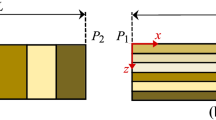Abstract
The problem of the generation of an uncompensated electric space charge in weakly conducting viscous fluid channel flows in which the medium interacts electrochemically with an interface is investigated for an arbitrary relation between the mobilities of the charged particles of different kinds. New models of the electrochemical surface processes are considered. The effect of the parameters of these processes on the electrification current and on the time taken by the electric parameters of the medium is studied to reach saturation. The possibility of the generation of strong induced electric fields on the interface is justified theoretically, two basic parameters affecting the strength of these fields are determined, and an explanation of the discharge process observed in the experiments in the form of local fluid glow zones is proposed.
Similar content being viewed by others
References
G. Touchard, “Flow electrification of liquids,” J. Electrostatics, 51-52, 440–447 (2001).
L. T. Chernyi, “Electrohydrodynamicmodels and methods of calculating electrification of organic liquids in pipe flows,” Dokl. Akad. Nauk SSSR, 271, No. 3, 573–577 (1983).
I. L. Pankrat’eva and V. A. Polyanskii, “Simulation of electrohydrodynamic flows in weakly conducting liquids,” Zh. Prikl. Mekh. Tekh. Phys., 36, No. 4, 36–44 (1995).
V. A. Polyanskii and V. N. Pribylov, “Effect of streamwise diffusion on the liquid dielectric electrification current in channel flow,” Kolloid. Zh., 66, No. 3, 372–375 (2004).
V. V. Gogosov, K. V. Polyanskii, V. A. Polyanskii, G. A. Shaposhnikova, and A.A. Vartanyan, “Modeling of nonstationary processes in channels of EHD pump,” J. Electrostatics, 34, 245–262 (1995).
V. A. Polyanskii and I. L. Pankratieva, “Multilayer charged structures in nonpolar dielectric liquids,” J. Coll. and Interface Sci., 230, 306–311 (2000).
V.N. Pribylov, “Experimental investigation of the dielectric liquid electrification current in a cylindrical pipe,” Kolloid. Zh., 58, No. 4, 524–527 (1996).
T. Paillat, E. Moreau, and G. Touchard, “Space charge density at the wall in the case of heptane flowing through an insulating pipe,” J. Electrostatics, 53, 171–182 (2001).
I. L. Pankrat’eva and V.A. Polyanskii, “Electrification of weakly conducting media in the neighborhood of an interface,” in: Modern Problems of Electrophysics and Electrohydrodynamics of Fluids. Proceedings of VII Intern. Symp., Saint-Petersburg, June 25–29, 2003 [in Russian], Saint-Petersburg (2003), pp. 203–207.
A. G. Isaev, A. S. Agaev, V. M. Abbasov, E. K. Gadzhieva, M. A. Usacheva, and Kh. A. Nabibekova, “Antistatic additives for light oil,” in: Protection from the Harmful Effects of Static Electricity in the National Economy. Abstr. of III All-Union Sci. Tech. Conf., Severodonetsk, September, 1984 [in Russian], Severodonetsk (1984), pp. 113–114.
H. Massey, Negative Ions, Cambridge University Press, London (1976).
I. L. Pankrat’eva and V.A. Polyanskii, “Generation of strong electric fields in liquids flows through narrow channels,” Dokl. Ros. Akad. Nauk, 403, No. 5, 619–622 (2005).
D. S. Baranov, N. S. Bukharin, S.Ya. Gertsenshtein, and A.A. Monakhov, “Electrification of a weakly conducting liquid in a narrow dielectric channel,” in: Abstr. of XIII School-Workshop “Modern Problems of Aerodynamics,” September 5–15, 2005, Sochi, “Burevestnik” MGU [in Russian], Moscow State University Press, Moscow (2005), p. 14.
V. I. Vedeneeev, L.V. Gurvich, V.N. Kondrat’ev, V.A. Medvedev, and E. L. Frankevich, Chemical Bond Rupture Energy. Ionization Potentials and Electron Affinity [in Russian], Izd-vo AN SSSR, Moscow (1962).
A. B. Vatazhin and K. E. Ulybyshev, “Model of electric current formation in aircraft jet engine ducts,” Fluid Dynamics, 35, No. 5, 748–757 (2000).
J. Lawton and F. J. Weinberg, Electrical Aspects of Combustion, Clarendon Press, London (1969).
Additional information
__________
Translated from Izvestiya Rossiiskoi Academii Nauk, Mekhanika Zhidkosti i Gaza, No. 2, 2006, pp. 3–16
Original Russian Text Copyright © 2006 by Pankrat’eva and Polyanskii.
Rights and permissions
About this article
Cite this article
Pankrat’eva, I.L., Polyanskii, V.A. Electrification of weakly conducting liquids in the neighborhood of a wall. Fluid Dyn 41, 173–185 (2006). https://doi.org/10.1007/s10697-006-0032-0
Received:
Issue Date:
DOI: https://doi.org/10.1007/s10697-006-0032-0




